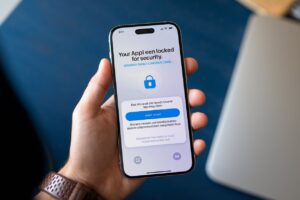In today’s digital world, safeguarding your personal information is crucial. One sensitive detail you might need to send via email is your Social Security number (SSN). Sharing your SSN can be risky if not handled correctly, whether for job applications, financial transactions, or other essential purposes.
While convenient, emails are only sometimes secure. Understanding the importance of protecting your SSN and following the correct practices can help avoid potential security breaches. In this article, we’ll provide essential tips for securely sending your SSN via email, ensuring your information stays safe from unauthorized access.
Risks of Sending SSNs via Email
Sending your Social Security number (SSN) via email comes with several risks that you should be aware of:
Data Interception
Emails travelling over the Internet can be intercepted. Without proper encryption, unauthorized individuals could access your SSN during transmission.
Phishing Scams
Fraudsters may use fake email addresses or websites to trick you into sending your SSN to them. These scams can lead to identity theft if you’re not careful.
Account Breaches
Any sensitive information, including your SSN, can be exposed and misused if your email account is hacked.
Lack of Encryption
Many email services don’t automatically encrypt messages. Without encryption, your SSN is vulnerable to being read by anyone who gains access to your email.
Being aware of these risks helps you take steps to protect your personal information. The following sections will cover practical tips to ensure your SSN is sent securely via email.
Essential Tips for Secure Email Transmission
Follow these essential tips to ensure the safe transmission of your Social Security number (SSN) via email.
Verify the Recipient
Double-check the email address and confirm the recipient’s identity before sending your SSN. This can prevent accidental or unauthorized sharing of your information.
Use Encryption
Encrypt your email to protect its content. Encryption converts your email into a code only the intended recipient can decode. Many email services offer built-in encryption options or allow you to use third-party encryption tools.
Check for Secure Protocols
Ensure your email provider uses protocols like TLS (Transport Layer Security). TLS helps protect your email from being intercepted during transmission.
Password Protection
Use a robust and unique password for your email account and enable two-factor authentication (2FA). This adds an extra layer of security, making it harder for unauthorized users to access your account.
Best Practices for Email Security
To further enhance the security of your email communications, consider these best practices:
Create Strong Passwords
Use complex and unique passwords for your email accounts. A strong password typically includes letters, numbers, and special characters. Avoid using easily guessable information like birthdays or common words.
Regularly Update Security Settings
Keep your email security settings up to date. Review and adjust your privacy and security settings regularly to meet current best practices.
Use Two-Factor Authentication (2FA)
Enable 2FA for an extra layer of security. This feature requires a second verification form, such as a text message or authentication app, and your password.
Be Cautious with Email Attachments
Avoid opening attachments or clicking on links from unknown or suspicious emails. These can be used to distribute malware or phishing attempts.
Monitor Your Account Activity
Please regularly check your email account for unusual activity and promptly address any signs of unauthorized access or suspicious behaviour.
By following these best practices, you can significantly reduce the risk of your email account being compromised and your sensitive information being exposed.
What to Do If Security Is Compromised
If you suspect that your Social Security number (SSN) or email account has been compromised, take the following steps to address and mitigate the situation:
Act Quickly
Act immediately if you notice any unusual activity or receive alerts about a potential breach. The sooner you address the issue, the better you can protect yourself from further harm.
Change Your Passwords
Update your email account password and any other accounts that may be affected. Ensure that your new password is strong and unique. If you use the same password across multiple sites, change those passwords too.
Enable Two-Factor Authentication (2FA)
Enable 2FA for your email and other vital accounts if you haven’t already. This adds an extra layer of security and makes it harder for unauthorized users to access your accounts.
Monitor Your Accounts
Check your bank accounts, credit reports, and other financial statements for signs of unauthorized transactions or suspicious activity.
Report the Incident
Notify the relevant authorities about the breach. This might include contacting your email provider’s support team, reporting the incident to identity theft protection services, or filing a report with the Federal Trade Commission (FTC) if you’re in the U.S.
Consider a Credit Freeze
If your SSN has been exposed, you might want to place a fraud alert or credit freeze on your credit report. This can help prevent new accounts from being opened in your name without your knowledge.
Conclusion
In summary, sending your Social Security number via email requires careful attention to security to protect against potential risks. By following the tips outlined in this guide—such as verifying the recipient, using encryption, and employing solid passwords—you can significantly reduce the chances of your sensitive information being compromised.
To safeguard your data, always be cautious and proactive about email security. Regularly updating your security settings, monitoring your accounts, and taking immediate action if you suspect a breach is essential to maintaining your privacy and security.
Consider using additional resources, such as encryption tools and identity theft protection services, to protect your sensitive information further. Staying informed and vigilant will help ensure your sensitive information remains secure in an ever-evolving digital landscape.





















35 thoughts on “Sending Your Social Security Number Safely via Email: Essential Tips”
Hey, I’m Jack. Your blog is a game-changer! The content is insightful, well-researched, and always relevant. Great job!
The silicon pipes provided by Elite Pipe Factory are engineered to deliver superior heat resistance and flexibility. These pipes are essential for applications where temperature fluctuations are a concern, and their durability makes them suitable for various industrial processes. Elite Pipe Factory’s commitment to quality ensures that our silicon pipes are among the best available in Iraq. Visit us at elitepipeiraq.com. for more details.
Family Dollar There is definately a lot to find out about this subject. I like all the points you made
The analysis made me think about the topic in a new way. Thanks for the insightful read.
Delightful read. The passion is visible, or at least, very well faked.
I’m so glad I stumbled upon this article. It was exactly what I needed to read!
The breadth of The knowledge is amazing. Thanks for sharing The insights with us.
A masterpiece of writing! You’ve covered all bases with elegance.
Handling topics with grace and authority, like a professor, but without the monotone lectures.
شركة Bwer هي أحد الموردين الرئيسيين لموازين الشاحنات ذات الجسور في العراق، حيث تقدم مجموعة كاملة من الحلول لقياس حمولة المركبات بدقة. وتغطي خدماتها كل جانب من جوانب موازين الشاحنات، من تركيب وصيانة موازين الشاحنات إلى المعايرة والإصلاح. تقدم شركة Bwer موازين شاحنات تجارية وموازين شاحنات صناعية وأنظمة موازين جسور محورية، مصممة لتلبية متطلبات التطبيقات الثقيلة. تتضمن موازين الشاحنات الإلكترونية وموازين الشاحنات الرقمية من شركة Bwer تقنية متقدمة، مما يضمن قياسات دقيقة وموثوقة. تم تصميم موازين الشاحنات الثقيلة الخاصة بهم للبيئات الوعرة، مما يجعلها مناسبة للصناعات مثل الخدمات اللوجستية والزراعة والبناء. سواء كنت تبحث عن موازين شاحنات للبيع أو الإيجار أو التأجير، توفر شركة Bwer خيارات مرنة لتناسب احتياجاتك، بما في ذلك أجزاء موازين الشاحنات والملحقات والبرامج لتحسين الأداء. بصفتها شركة مصنعة موثوقة لموازين الشاحنات، تقدم شركة Bwer خدمات معايرة موازين الشاحنات المعتمدة، مما يضمن الامتثال لمعايير الصناعة. تشمل خدماتها فحص موازين الشاحنات والشهادات وخدمات الإصلاح، مما يدعم موثوقية أنظمة موازين الشاحنات الخاصة بك على المدى الطويل. بفضل فريق من الخبراء، تضمن شركة Bwer تركيب وصيانة موازين الشاحنات بسلاسة، مما يحافظ على سير عملياتك بسلاسة. لمزيد من المعلومات حول أسعار موازين الشاحنات، وتكاليف التركيب، أو لمعرفة المزيد عن مجموعة موازين الشاحنات ذات الجسور وغيرها من المنتجات، تفضل بزيارة موقع شركة Bwer على الإنترنت على bwerpipes.com
Your point of view caught my eye and was very interesting. Thanks. I have a question for you.
Your article helped me a lot, is there any more related content? Thanks!
A perfect blend of informative and entertaining, like the ideal date night conversation.
Fantastic job breaking down this topic, like a demolition crew for my misconceptions.
The attention to detail is remarkable, like a detective at a crime scene, but for words.
You’ve articulated The points with such finesse. Truly a pleasure to read.
The creativity and intelligence shine through this post. Amazing job!
A masterpiece of writing! You’ve covered all bases with elegance.
Thank you for making hard to understand topics accessible and engaging.
Most comprehensive article on this topic. I guess internet rabbit holes do pay off.
I admire the way you tackled this hard to understand issue. Very enlightening!
The ability to break down tough concepts is as impressive as a magician’s trick. Color me amazed.
Adding value to the conversation, because what’s a discussion without The two cents?
I learned a lot, and now I’m curious about what else you could teach me. The intelligence is as captivating as The prose.
Your article helped me a lot, is there any more related content? Thanks!
Thank you for your sharing. I am worried that I lack creative ideas. It is your article that makes me full of hope. Thank you. But, I have a question, can you help me?
Your point of view caught my eye and was very interesting. Thanks. I have a question for you.
The analysis had the perfect mix of depth and clarity, like a perfectly mixed cocktail that I just can’t get enough of.
Noodlemagazine Very knowledgeable articles or reviews right now
The blend of informative and entertaining content on the state of the country is perfect. I enjoyed every word.
I’m in awe of the way you handle topics with both grace and authority.
Thanks for sharing. I read many of your blog posts, cool, your blog is very good.
Thank you for your sharing. I am worried that I lack creative ideas. It is your article that makes me full of hope. Thank you. But, I have a question, can you help me? https://accounts.binance.com/register?ref=P9L9FQKY
Your article helped me a lot, is there any more related content? Thanks!
My pup’s playdates at Charlotte Dog Park are the best—he’s got a whole squad now!